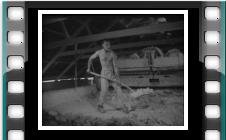HOW CLAY WAS WORKED
In the early days, the china clay industry involved heavy manual labour. The topsoil and subsoil were first removed so that the kaolinised granite or clay could be reached. The waste material was thrown by shovel to the surface in a series of steps. The white kaolinised granite was piled up and a stream of water poured over it so that the soft clay rock would disintegrate. This disintegration would cause the sand to separate and the finer sand, mica and clay would be carried away in the water. This was called the clay stream.
The clay stream was passed through a succession of pits or tanks until in the final pits the clay particles settled out into a creamy mass, transferred to drying pans before being cut into blocks and moved to a drying house where it was laid out on shelves so that the circulating air could complete the drying process. The blocks were then cleaned and packed into wooden casks for transport.
The problem of raising clay to the surface became more difficult as the pits became deeper. The Cornish miners were very adept at using gravity whenever possible. Most of the clay pits were on high ground and by digging a tunnel, or adit into the hillside under the pit they could allow the clay stream to flow down to a clay yard where the refining and drying processes took place. Where the geography was unsuitable they had to use manual pumps, followed by water wheels, steam engines and eventually electric pumps. In the modern industry the clay is often pumped for miles to the refining plants and the driers.
Gradually mechanisation took over the manual work. Excavators and dumper trucks enabled a huge expansion in the size of the pits and the kaolinised granite was broken up using high pressure hoses. Conveyors took the sand to the large tips which are such a dominant feature of the landscape today. Great changes have also taken place in the drying process. The air drys were first replaced by pan drys where the clay was transferred onto a tiled floor heated by burning coal. When the clay was dry it was shovelled into the linhay and it was eventually loaded onto lorries or railway wagons. This was heavy, dirty work.
Click to play a short extract from
'Treviscoe'
courtesy South West Film
and Television Archive

